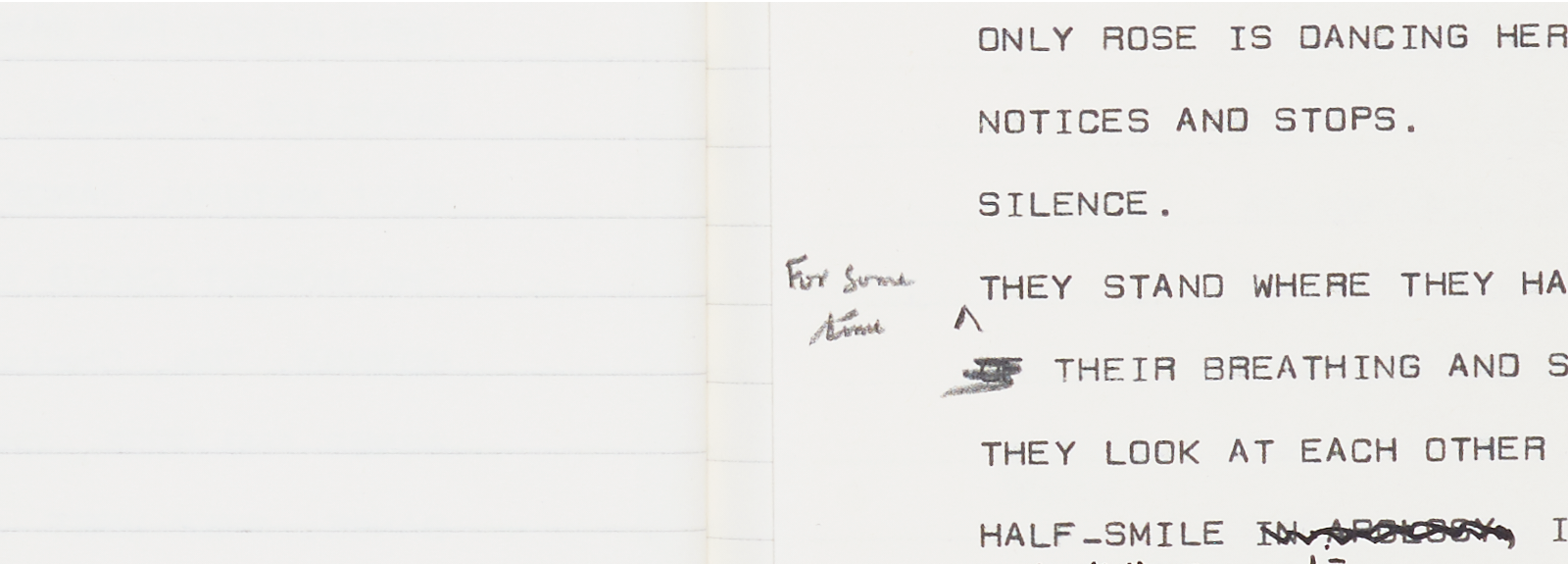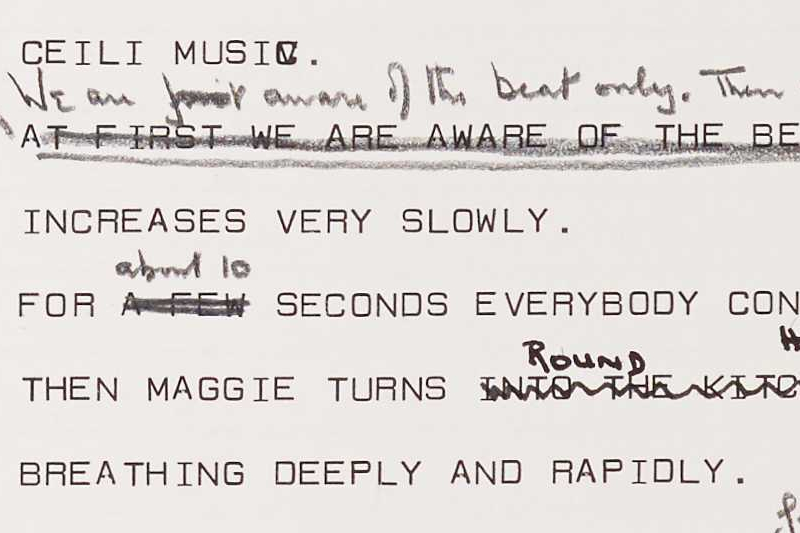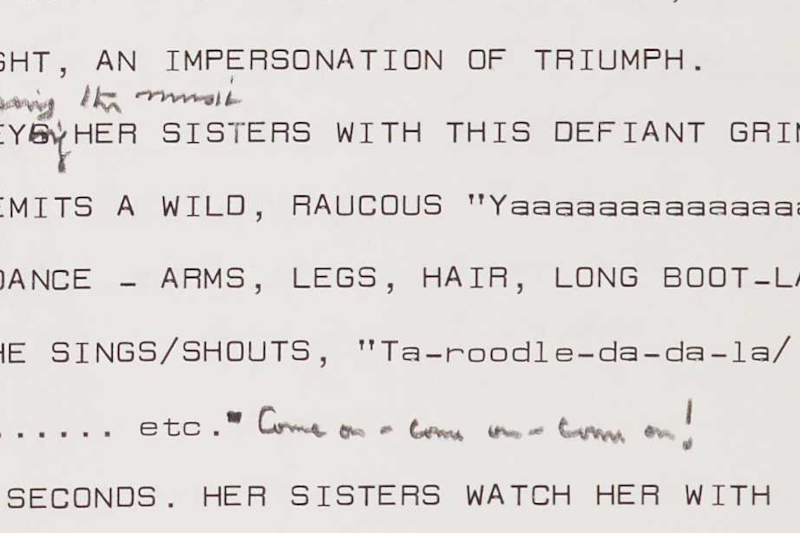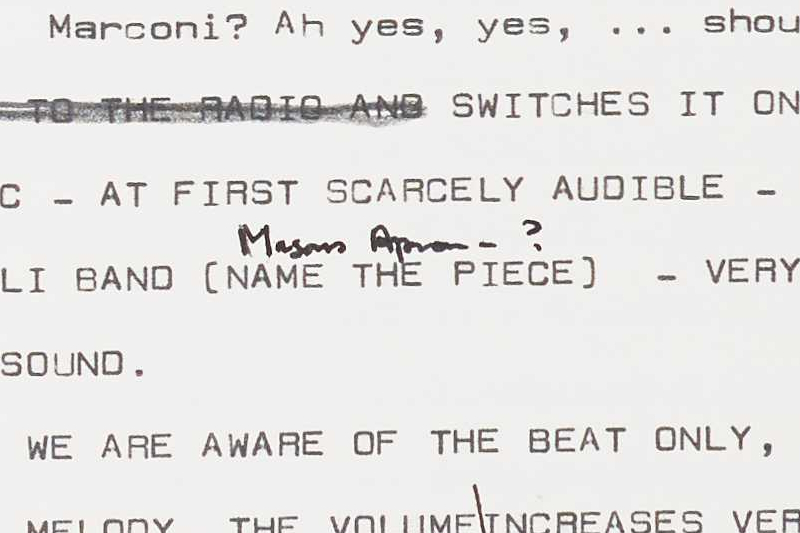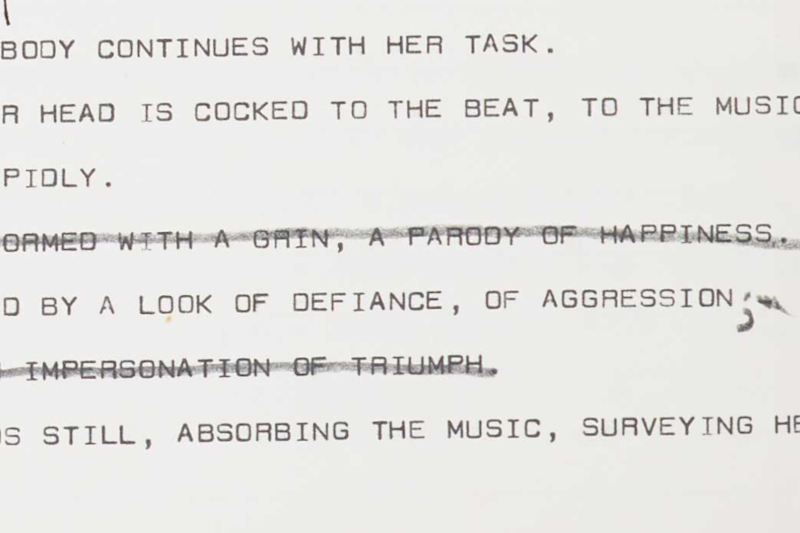Dancing at Lughnasa (1990)
By Dr Bernadette Sweeney
Dancing at Lughnasa, first produced by the Abbey Theatre in 1990, has received much critical attention – with particular focus given to Friel’s efforts to move outside spoken language in his use of the image of dance in the play.1 The digital archive offers the opportunity to chart the progression of this image in Friel’s successive manuscripts.
Looking back several decades to 1936, the play was written as a tribute of sorts to Friel’s mother’s family – he dedicated it to ‘those five brave Glenties women’. It is a moving tribute indeed, in which the adult Michael Evans recalls a childhood summer in Ballybeg, acting by turns as witness, narrator and conjurer. Michael reflects on the abiding memory of his mother and aunts: ‘Dancing as if language had surrendered to music… Dancing as if language no longer existed because words were no longer necessary’.
There are various instances of dancing in the script. We see Friel describe a formal dance to evoke the romance and nostalgia of a lost and ultimately disappointing love, as the younger Mundy sister, Chris – Michael’s mother – performs a ‘ballroom’ dance in the garden with her lover Gerry, the boy’s father. In contrast, an informal dance describes the plight of Fr Jack, recently returned from Uganda, sick and disgraced: ‘He shuffles quickly across the kitchen floor, hands behind his back, eyes on the ground, as if he were intent on some engagement elsewhere’.
The most notable of all the dances, however, is the scene in Act I, when the five sisters dance to ‘The Mason’s Apron’, a céilí broadcast on the new ‘Marconi’ wireless set which has been installed in the kitchen. This celebratory, and celebrated, scene was central to the critical success of the play; the archival papers show how Friel takes scrupulous care over each element of its staging. In the annotated manuscripts MS 37,104.4 and MS 37,104.5 [Brian Friel Digital Archive], Friel develops the dance – refining some ideas with subtle alterations, cementing or extending parts, or revising them altogether. These seemingly incremental changes each have a significant impact on this key physical image.2
In MS 37,104.4.29 [BFDA], as the dance begins, Friel refines what the sisters, and audience members, can hear. He makes more particular the progression from beat to melody – here his meticulousness becomes clear in determining the timing so specifically. In his handwriting we see: ‘At first, we are aware of the beat only. Then after a few seconds we hear the melody.’ He suggests a specific length of time as he continues to craft the scene, updating the stage direction: the draft line ‘for a few seconds everybody continues with her task’ becomes ‘for about 10 seconds everybody continues with her task’. He continues to make refinements, changing ‘[Maggie] looks at her sisters’ to shift the focus to the music instead: ‘Her head is cocked to the beat, the music’. Friel emphasises Maggie’s deeply felt response to the ‘raucous sound’ of the céilí on the wireless – and her role as an instigator among her sisters. Further down the page, in pencil additions over the typescript, Friel elaborates: at first, Maggie ‘stands still, absorbing the music’ before launching into the dance. Then, he has her issue a direct challenge to her sisters to join her, crying: ‘Come on – come on – come on!’ These amendments show Friel’s attention to detail in the opening seconds of the dance – juxtaposing rhythm and stillness, and Maggie’s direct incitement of her sisters.
In the version of the script on page MS 37,104.4.30 [BFDA], Friel develops each sister’s reaction as Maggie rouses them into dancing. Instead of letting her simply join in, Friel has Agnes hesitate at first, seeking her sisters’ approval: ‘Agnes looks around, as if for permission, leaps up’. Kate, who has a reputation as the sensible older sister, is initially alarmed and uneasy – though eventually even she cannot resist taking part. In handwriting on the left of the page, we find: ‘When Chris throws the surplice over her head, Kate cries out in horror – “Oh Christina” – but the sound is drowned.’ Friel adds another key section on the left-hand side towards the bottom of the page: ‘Throughout the dance, Agnes, Rose, Maggie & Chris shout-sing-call to each other above the music. Kate, alone after her initial shout, moves silently.’
Each time Friel revisited his draft, new refinements and additions brought this pivotal dance scene closer to its eventual form. Initially, he was unsure which piece of dance music would best suit the scene, but on page MS 37.104.5.1.33 [BFDA], we see him specify it for the first time. He jots in pen, ‘Mason’s Apron?’ above where he had typed an instruction to himself to ‘name the piece’ in parentheses.
On the same page, Friel decides against the description of Maggie beginning the dance with a parodic grin, crossing out his draft stage direction: ‘Suddenly, her face is transformed with a grin, a parody of happiness.’ He also removes the reference to ‘triumph’ in the following line and adds ‘Suddenly’: ‘Her features become animated by a look of defiance, of aggression, a crude mask of delight happiness, an impersonation of triumph.’ Perhaps he reasoned that the stage direction of an ‘impersonation’ of triumph would be too subtle to deliver to an audience without it simply reading as triumphant – this concern would later prove legitimate, as the dance continued to evolve towards being more celebratory, especially in the first touring production of 1990.
There were more notable amendments to come. On page MS 37,104.5.1.34 [BFDA], we see the crucial addition of the flour mask, which ties this moment of abandon both to Irish pre-Christian ritual, and to the African traditions that feature elsewhere in the play – as staged by the mask-like kites created by the child Michael3 and by the references to Father Jack’s experiences in Uganda. At the top of page MS 37,104.5.1.34 [BFDA], he adds: ‘Then she rubs her flour-covered fingers down her face, opens her mouth, emits a wild, raucous "Yaaaaaaaaaaaaaah!" and immediately begins to dance.’ In his handwriting on the next line, Friel reinforces the image of the flour mask when he adds the description of Maggie as ‘a white-faced dervish’.
Other refinements on this page of the manuscript include the removal of Agnes’s asking for permission to dance; we see Friel crossing out ‘as if for permission’ after ‘Agnes looks around’. Friel expands on his description of Agnes and her dancing skills here too – in pen towards the middle of the page, he writes: ‘Of all the sisters she [Agnes] moves most lyrically, most sensuously, most elegantly.’
Finally, on page 24 of this manuscript, listed as MS 37,104.5.1.35 [BFDA], we see how Friel worked on the transition to the next part of the play, as the sisters move back into the reality of their day-to-day lives and leave the abandon of the dance behind. We see that there is space left for a specific duration (‘The dance lasts [blank] minutes’) but this does not feature in the published version of the script.
More significantly, Friel’s reflections on the significance of the dance developed with successive drafts. As it reaches a climax, he considers its meaning in the lives of the sisters: ‘With this too loud music, this pounding percussion, this singing/shouting, this parodic reel, there is a sense of order being consciously subverted, of their own domesticity being crudely caricatured [sic] indeed of near-hysteria being induced.’ Here Friel crosses out ‘their own domesticity’, replacing it with ‘music, dance, their own femininity’.
The final published version of the script gives agency back to the sisters: ‘…there is a sense of order being consciously subverted, of the women consciously and crudely caricaturing themselves’ [my emphasis]. In this ultimate version, the sisters ‘caricaturing themselves’ is an intention that arises from within the text, and in each character in turn.
[1] See Sweeney, B., ‘Performing Language’, in Performing the Body in Irish Theatre, Palgrave (2008).
[2] While Friel’s influence as the author of the scene is paramount, the dance image was developed and adapted further from one production to the next, as new creative teams took to performing it.
[3] ‘On each kite is painted a crude, cruel, grinning face, primitively drawn, garishly painted’ (Faber, p. 70).
Bernadette Sweeney is based in Missoula, where she is Professor of Theatre / Head of Performance & Practice at the University of Montana. A native of Ireland, she was awarded a Ph.D. by the School of Drama, Trinity College Dublin, in 2002. Her doctoral research was subsequently published by Palgrave Macmillan in 2008 as Performing the Body in Irish Theatre. In 2010 she published her second book, The Theatre of Tom MacIntyre: Strays from the Ether, with Carysfort Press, Dublin, co-edited with Marie Kelly. Bernadette has also worked as a director and theatre practitioner for many years.
-
Introducing the Friel Papers
To mark the launch of the Brian Friel Digital Archive in December 2022, the Friel Reimagined project commissioned a series of critical essays to illuminate the creation of Friel's most acclaimed plays and provide unique insights into the life and work of this most accomplished dramatist.
Author Play Dr Kelly Matthews, Framingham State University Philadelphia, Here I Come! Dr Lisa Fitzpatrick, Ulster University The Freedom of the City Mr David Grant, Queen's University Belfast Faith Healer Dr Alison Garden, Queen's University Belfast Translations Dr Bernadette Sweeney, University of Montana Dancing at Lughnasa

